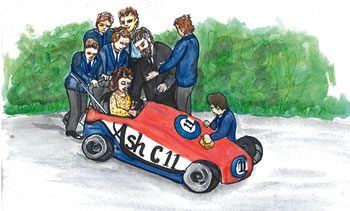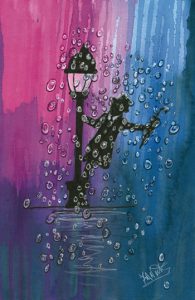A Silver Lining to a Cloud of Grief
The pragmatic lens through which an adolescent boy looks is very narrow and has room only for himself. The pragmatic lens through which a mature adult man looks can incorporate the idea of doing things for others.
-- Celia Lashlie,He’ll Be OK, Growing Gorgeous Boys into Good Men
They say when one door closes, another door opens. The new door may not be open for long, but it may be just enough for healing to begin.
A few years ago, I began work for the Society of St. Vincent de Paul as a Youth Co-ordinator. My mission – to encourage young people to help others in need.
In being introduced to the Principal of one of the schools I would work with, I was jokingly told, “You’ll find that you get more girls on board than boys, it doesn’t kick in with guys until the age of 90 that they really should do something for someone else”. Sure enough, the stories from other youth co-ordinators reiterated the fact that this line of work attracted far more girls than boys.
The challenge came when I heard about a student at the local Catholic College who had died. The student, who had a heart deformity, came from a family whose mother was blind. This led me to investigate what could be done to care for the family during this time.
My first port of call was a teacher who had taught Asher and had remained close to the family, as well as the group of students with whom Asher had been friends. George had kept a story that Asher had written, and was keen to make a recording of it for the family. His suggestion was that we gather as many as possible of the students who knew Asher to record anecdotal remembrances of the fun that they all had.
A group of three young men, who had been among Asher’s closest friends, were part of this initial project. When it came time to visit Asher’s family, they loved the CD recording. They laughed, they cried; and it helped in the healing process. The family spoke about how Jono, their youngest and only other child, was coming to terms with losing his brother.
And it was obvious that these young men who had made the CD really needed a group that could support them.
It was from these beginnings that the In-Vince-able Young Men’s group came into existence.
A few weeks later, it was George who needed help. He was moving house and needed some extra hands to assist. The team of guys, the In-Vince-able Young Men’s group, willingly got together to do whatever was necessary.
It was obvious that in setting up a group for young men, the activities needed to be ones that would capture their imaginations, put their abilities to good use, and help them to realise they had valuable skills to offer the community.
Around this time I came across a design to make a go-kart. I suggested to the group that they might build go-karts to give away to children in need, children whose families were struggling and didn’t have much. It was suggested that the first go-kart built should be road-tested at the Collingwood Derby Challenge before it was given away.
One of the young men came up with a new design, using as much re-cycled material as possible. Trips to the local Refuse Stations yielded items such as bicycles, a windsurfer frame, even a mountain buggy, and these were dismantled for their parts. George, the man who had needed help moving house, had been an engineer before becoming a teacher, and the technology teacher at the Catholic College come on board, opening up the technology room for us to use, and assisting with construction.
In the days leading up to the big race, more young men got involved, and parents called in to the workshop to check on progress, among them, Asher’s mother and father. As Gill, Asher’s mother who is blind, was led to the go-kart, the guys stood back, allowing her the opportunity to feel the go-kart from front to back. She was gently guided to sit in the driver’s seat to imagine what it would feel like driving down the hill in this machine. The guys had also designed their own number plate – AshC11, in honour of their friend who had died – which they were keen to show to Asher’s mum and dad. The healing wasn’t finished when the CD was made – it was continuing.
The night before the race, as the guys spray-painted the go-kart, one of them asked, “So what are we going to do with this when the race is over?” “You know,” came the reply, “I think we should find some child in the community who really deserves it, and give it away.” The guys had risen to the challenge. Despite their huge personal investment in creating the go-kart, they still thought of others over and above themselves. As the go-kart sped down Collingwood Street the next day, the students and their families watched eagerly.
One thing shone out in spite of the fact that the day was washed out with rain. In what had been a cloud of grief, the go-kart project had become the silver lining.
As Jono’s and Asher’s mother so aptly put it afterwards, “Although there is little we can do about the storms of life, we can learn to dance in the rain”.

 Entries(RSS)
Entries(RSS)